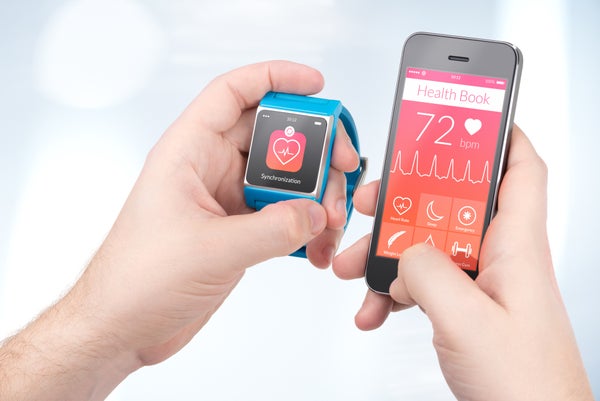Geneticist Michael Snyder has long been a fan of studying himself. Looking into his own genetics, he realized five years ago that he was at high risk of developing diabetes despite his slim build and running habit. So he was already inclined to use wearable fitness tracking devices—the high-tech wristbands that can transmit data about activity level, heart rate and sleep patterns to one’s phone or computer, which records the information. But being a Stanford scientist, Snyder was not content to simply wear one of these devices. Instead, he strapped on eight of them every day for two years to see if there were differences among them. He and several colleagues also put the monitors on 60 volunteers to check if Snyder’s results were representative of others—which they were.
The researchers released their results in a new study published online Thursday in PLoS Biology, concluding that the devices—promoted to help people lose weight and stay fit—can also reveal personalized circadian rhythms, track changes in specific environments such as airplane cabins during flight and combine biosensor information with medical measurements to help detect when wearers are falling ill. The research team developed a computational algorithm that can analyze signals from the devices to reveal very early signs of trouble—including differences in insulin sensitivity, which may help diagnose type 2 diabetes. “Too much of the time we spend time measuring people when they’re sick,” Snyder says. “What we really want to understand is what does it mean to define a healthy state, then quickly identify deviations from that state [when someone is falling ill]. I think the wearables are going to be a big part of that.”
Snyder and his colleagues collected more than two billion bits of data from the 60 volunteers, who wore as many as seven of the devices daily for as long as 11 months, to track multiple metrics and see if some devices were more accurate than others. They gathered information on weight, heart rate, blood oxygen, skin temperature, activity and calories expended. The participants—some of whom knew they were diabetic—also submitted to regular lab tests of their blood chemistry and gene expression as well as other measurements. Some subjects tracked during airplane travel showed a consistent drop in their oxygen levels above 8,000 feet in elevation, Snyder says, likely explaining why so many people start to feel sleepy early on during a flight. Snyder found that his own oxygen levels tended to rebound by the time he landed.
On supporting science journalism
If you're enjoying this article, consider supporting our award-winning journalism by subscribing. By purchasing a subscription you are helping to ensure the future of impactful stories about the discoveries and ideas shaping our world today.
Snyder tracked himself getting sick several times. Once, on a flight to Norway, his devices picked up something strange. His blood oxygen level did not bounce back as usual. Then they showed he had developed a low-grade fever. On a hunch, Snyder—who recalled being in a possible tick habitat in Massachusetts a week earlier—asked a doctor to test him for Lyme disease. He was diagnosed at the earliest stage of the often grueling illness, when treatment has the best chance to succeed. Without the tracking, Snyder says, he would likely have ignored the signs until his infection was more advanced.
The devices also accurately tracked the return of Snyder’s insulin sensitivity, which he had kept under control by exercise. What he saw in himself was similar to what the researchers detected in other study volunteers, including changes in insulin sensitivity and the early indication of illness, he says. Snyder compares the information from the sensors with seeing the “check engine” light in your car. “You might hear some knocks” in the engine beforehand, tipping you off to a potential problem, but “it’s nice to see a little light when something’s not right,” he says.
Snyder believes the devices should be useful for tracking and better understanding the physiological effects of aging. “We will see personal markers of aging as we follow people very closely,” he says. “Understanding your baseline while you’re healthy is really, really important.”
Next, Snyder hopes researchers will try to figure out which wearable monitors are best at health detection (so one need not wear the eight devices that he straps on every day—and has to remember to keep charged). His team counted more than 500 different devices, offering different types of data, the last time they checked in the summer of 2015.
Peter Rasmussen, medical director for distance health at the Cleveland Clinic, was not involved in the study but shares Snyder’s enthusiasm for these wearable devices—and agrees that their full potential has yet to be realized. “We’re really at the embryonic stages of these things,” he says. Rasmussen hopes that in the next few years data from the trackers can be integrated into a person’s medical record, allowing health care providers to monitor the individual continuously over time. Then, he says, “we can begin to apply some higher-level artificial intelligence to machine learning to begin to look for trends we don’t even know exist. We may find wonderful things that we can [use to] intervene on patients before they are actually ill.”
